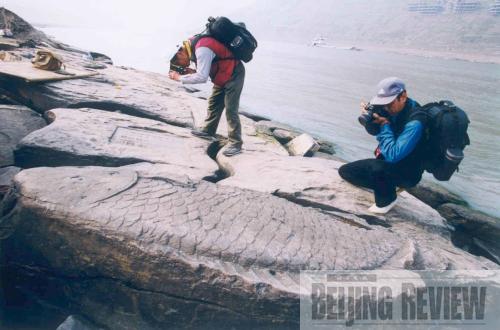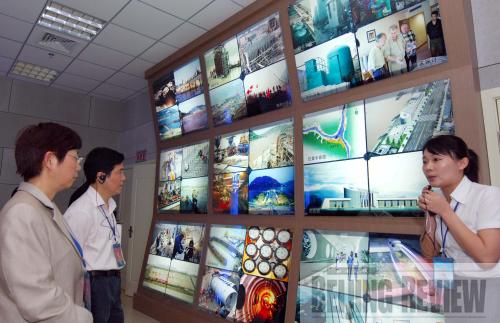|
 |
|
UNIQUE MOMENT: Photographers take shots of the Baiheliang ancient carvings before they were submerged in 2008 (CFP) |
It used to be famous for hot pickled vegetables, but now Fuling, a city in southwest China's Chongqing Municipality, has a new claim to fame.
On May 18, International Museum Day, an underwater museum was opened to the public in the city, which is located along the Yangtze River, the longest river in China. Known as the Baiheliang Underwater Museum, it contains a preserved natural reef that was used to measure changes in the water level of the Yangtze about 1,200 years ago.
 |
| HI-TECH MUSEUM: A bank of computer screens gives visitors to the underwater museum updated information (LIU CHAN) |
Baiheliang, literally White Crane Ridge, is a 1,600-meter-long and 10 to 15-meter-wide smooth stone ridge engraved with inscriptions about the Yangtze, dating back to the Tang Dynasty (618-907).
On the huge rock are 18 fish sculptures, which were used to measure water levels during the dry season period of 72 years out of the past 1,200 years. One of the sculptures' eyes marks the zero water level of the upper and middle reaches of the river.
It is said that under normal conditions the entire ridge was submerged in water, and it would only emerge during the dry season lasting from December to March the next year.
Local people say that when the stone fishes come out of the water, the next year would be a bumper year. This therefore became a good omen.
World's oldest water measurer
The ridge was in use more than 1,000 years before the first water gauge was set up in the river in 1865, and is believed to be the world's oldest hydrographic survey device. The United Nations Educational, Scientific and Cultural Organization describes the site as the only ancient hydrological station in the world that has been completely preserved.
The records of the water levels of the Yangtze reflect the river's changes during the dry seasons in the past, providing important information for today's research on hydrology and changes in the regional or even the world climate. The construction of some important irrigation works on the Yangtze was partly based on the records carved into the rock.
Besides its importance in hydrology, another highlight of the ridge is its artistic value. Because of the special role of the huge rock, numerous scholars, poets and calligraphers in the past would carve inscriptions to express their feelings on visiting the site. Around 165 inscriptions that consist of approximately 30,000 characters were found on the rock, including an inscription from Huang Tingjian, one of the outstanding scholars and calligraphers in the Song Dynasty (960-1279).
Because of its high value in science, history and art, the ridge is seen as one of the national treasures of China.
However, owing to the construction of the Three Gorges Dam, the site was submerged 40 meters below the water surface. How to protect the treasure became a big problem.
A national treasure
In early 1994, more than 10 academicians from the Chinese Academy of Engineering, along with experts on hydrology, architecture, shipping and cultural relic protection, were engaged in working out the best way to preserve the ridge.
| 